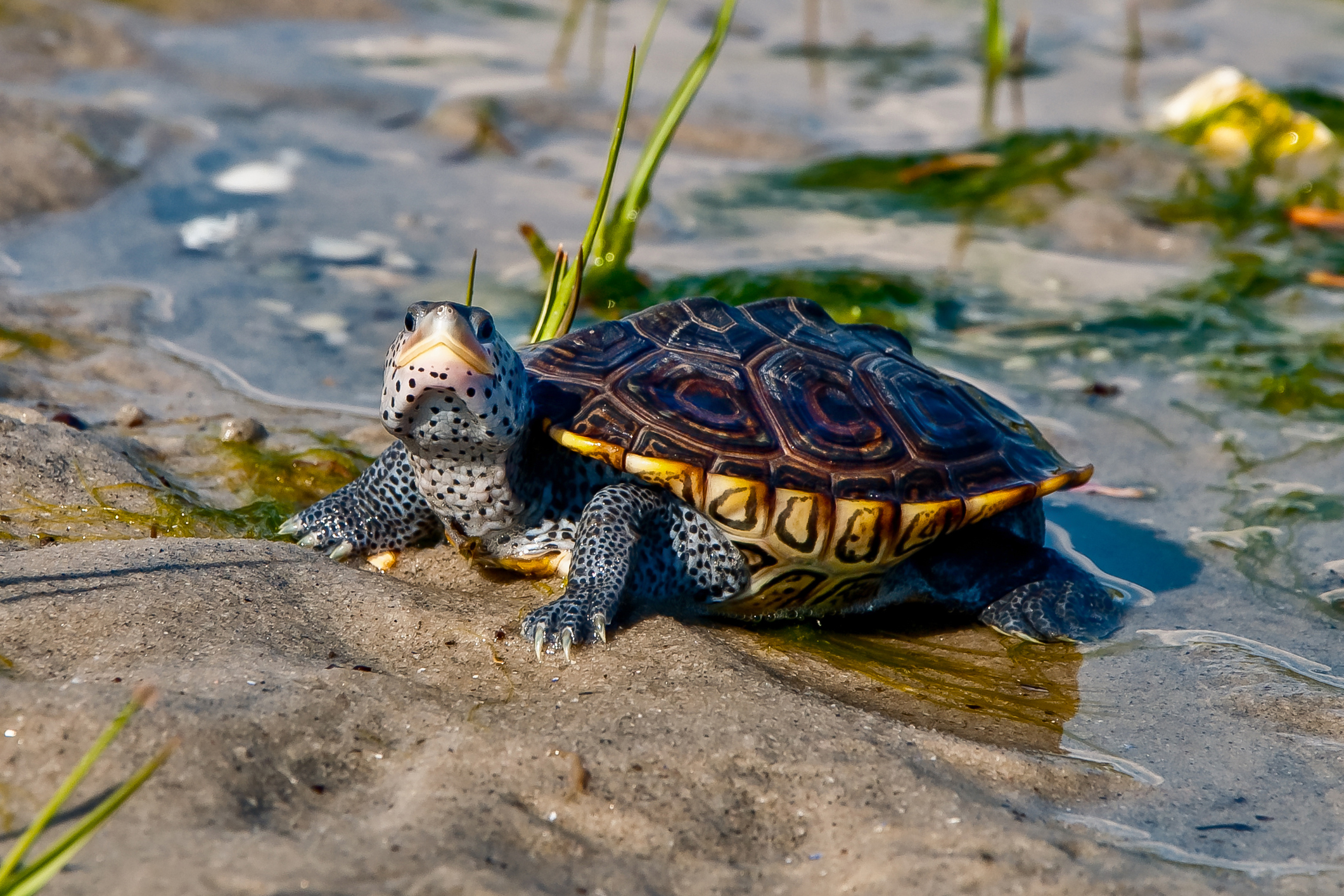North Fork Terrapin Turtle Deaths Were Preventable

Seven dead terrapin turtles were found washed up on a Southold beach on July 9. All seven were females of breeding age. They were found on South Harbor Beach, bloated but with no apparent trauma. The New York State Department of Environmental Conservation determined their deaths were likely caused by drowning in crab traps.
“Each turtle had 15 to 20 eggs in them,” says Karen Testa, executive director of Turtle Rescue of the Hamptons, based in Jamesport.
This is breeding season. The females are hungry and are lured into the crab traps with the bait.
With their population in decline, the loss of seven breeding females has a big impact on the population. Testa estimates it will take 10 years to replace each of the seven killed. According to John Turner, senior conservation policy advocate for Seatuck Environmental Association, the current population of terrapins may be in the low thousands.
Diamondback terrapins, with their beautiful carapace (shell) and slate-blue flippers, are in decline. The most recent State Wildlife Action Plan, from 2015, identifies terrapins as a “Species of Greatest Conservation Need” due to habitat loss, nest predation and incidental capture. Without premature death, the turtles normally live up to 70 years.
Diamondback terrapins are the only species native to the U.S. that live exclusively in brackish saltwater marshes and bays. They are not classified as sea turtles, but their populations are under stress, with crab traps and boat strikes considered primary threats.
Interestingly, diamondback terrapins had been safe from crab traps on the North Shore of Long Island, including in many North Fork bays and inlets. It was not uncommon to see them nesting and hatching on local beaches. Tragically, climate is expanding the range of blue crabs into terrapin habitat. Crab trappers followed the crabs, and now these traps are a major threat for the turtles.
Unlike crabs, terrapins cannot “breathe” oxygen from the water; they need to surface every few minutes for air. So when they swim into crab traps, attracted by the same bait that crabs prefer, they are trapped and drown.
Other threats the turtles face are primarily caused by humans: many are hit by jet skis or crushed by motor vehicles on land. Bulkheads and shoreline hardening prevent their access to nesting areas.
In 2015, hundreds of terrapins were found dead on a beach near Flanders Bay, killed by a neurotoxin, saxitoxin, that thrived in an algal bloom. According to scientists, the increased saxitoxin levels were due to an infusion of nitrogen, the result of pesticides from golf courses, lawns, farms and septic systems infecting the delicate ecosystems of nearby harbors and bays.
While some threats may be more challenging to address, there is a simple solution to prevent crab trap deaths.
Terrapin Excluder Devices (TEDs) greatly reduce the number of turtles captured in crab traps, with no negative impact on the catch of blue crabs.
The simple device, easily attached to the existing opening with three zip ties, narrows the trap’s opening to prevent most turtles from entering, but it does not affect the capture of crabs. There is some evidence that TEDs may even increase fishermen’s blue crab catch, according to Carl LoBue, acting director of the Marine Crustaceans Unit for the DEC (as reported by The Nature Conservancy on March 27, 2018).
TEDs have been used successfully in the U.S. since 1987.
According to noaa.gov, “The southeastern shrimp fisheries — which once faced severe restrictions and closures to protect endangered sea turtles — have continued to operate while saving the lives of sea turtles by using TEDs.”
The DEC requires crab traps to be equipped with TEDs on all funnel entrances of non-collapsible crab pots set in creeks, coves, rivers, tributaries and near-shore harbors of the marine and coastal district. On the North Fork, they are required in prime terrapin habitats: creeks and harbors.
New crab pots come equipped with the devices, but many older pots have not been retrofitted.
“Turtles are the most highly endangered organisms in the world,” says Testa. Anything we can do to protect these vulnerable terrapins should be done. Testa urges people to clean fishing gear or any loose buoys and lines, as entanglement is another common cause of death.
Free TEDs can be picked up at the Turtle Rescue of the Hamptons at 111 Manor Lane, Jamesport, 7 a.m.–4 p.m. daily, or from the DEC.
It is important to call for help immediately if you find a turtle in trouble or washed up on the beach. Even when turtles appear lifeless, they can sometimes be revived.
Call the Turtle Rescue of the Hamptons’ 24-hour emergency number 631-779-3737 or the DEC at 1-800-847-7332.
More info on TEDs can be found at dec.ny.gov/docs/fish_marine_pdf/dmrteds.pdf. And for more on the Turtle Rescue of the Hamptons, visit turtlerescueofthehamptons.org.









